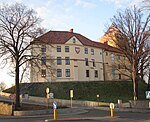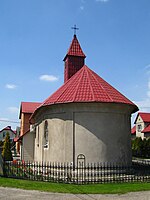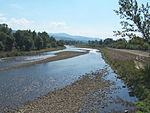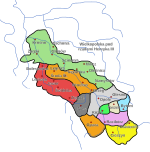Monowitz concentration camp

Monowitz (also known as Monowitz-Buna, Buna and Auschwitz III) was a Nazi concentration camp and labor camp (Arbeitslager) run by Nazi Germany in occupied Poland from 1942–1945, during World War II and the Holocaust. For most of its existence, Monowitz was a subcamp of the Auschwitz concentration camp; from November 1943 it and other Nazi subcamps in the area were jointly known as "Auschwitz III-subcamps" (KL Auschwitz III-Aussenlager). In November 1944 the Germans renamed it Monowitz concentration camp, after the village of Monowice (German: Monowitz) where it was built, in the annexed portion of Poland. SS Hauptsturmführer (Captain) Heinrich Schwarz was commandant from November 1943 to January 1945. The SS established the camp in October 1942 at the behest of IG Farben executives to provide slave labor for their Buna Werke (Buna Works) industrial complex. The name Buna was derived from the butadiene-based synthetic rubber and the chemical symbol for sodium (Na), a process of synthetic rubber production developed in Germany. Other German industrial enterprises built factories with their own subcamps, such as Siemens-Schuckert's Bobrek subcamp, close to Monowitz, to profit from the use of slave labor. The German armaments manufacturer Krupp, headed by SS member Alfried Krupp, also built their own manufacturing facilities near Monowitz.Monowitz held around 12,000 prisoners, the great majority of whom were Jews, in addition to non-Jewish criminals and political prisoners. The SS charged IG Farben three Reichsmarks (RM) per day for unskilled workers, four (RM) per hour for skilled workers, and one and one-half (RM) for children. The camp contained an "Arbeitsausbildungslager" (labor education camp) for non-Jewish prisoners viewed as not up to par with German work standards. The life expectancy of Jewish workers at Buna Werke was three to four months; for those working in the outlying mines, only one month. Those deemed unfit for work were gassed at Auschwitz II-Birkenau.Primo Levi, author of If This Is a Man (1947), survived Monowitz, as did Elie Wiesel, author of the Pulitzer Prize–winning book Night (1960), who was a teenage inmate there along with his father.
Excerpt from the Wikipedia article Monowitz concentration camp (License: CC BY-SA 3.0, Authors, Images).Monowitz concentration camp
Wiejska,
Geographical coordinates (GPS) Address Phone number Website Nearby Places Show on map
Geographical coordinates (GPS)
| Latitude | Longitude |
|---|---|
| N 50.0355 ° | E 19.278 ° |
Address
Synthos Dwory 7 Sp. z o.o. S.K.A.
Wiejska
32-661
Lesser Poland Voivodeship, Poland
Open on Google Maps









